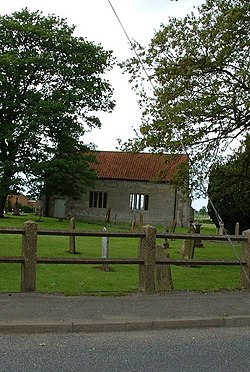Guyhirn
| Guyhirn | |
|---|---|
 Chapel of Ease, Guyhirn |
|
| Guyhirn shown within Cambridgeshire | |
| OS grid reference | TF399041 |
| Shire county | |
| Region | |
| Country | England |
| Sovereign state | United Kingdom |
| Post town | WISBECH |
| Postcode district | PE13 |
| EU Parliament | East of England |
Guyhirn is a small village near the town of Wisbech in Cambridgeshire, England. The village sits on the northern bank of the River Nene. The population is included in the civil parish of Wisbech St. Mary.
Guyhirn is found at a junction of two major "A" roads, where the A141 leaves the A47.
It has been suggested that the name may be a hybrid, a combination of guie, "guide" and hyrne, "angle, corner." With the tide flowing up the river as far as the village, it must always have been a critical point in the drainage of this part of the fens. It was nearby, at Ring's End, that John Morton, Bishop of Ely, erected his Tower House for the effective supervision of his new drain. Long before the construction of Morton's Leam the meeting here of fresh and salt water probably led to the construction of works for the safe guidance of their flow at this corner.
Also known as "Guyhirn Old Church" or "Guyhirn Puritan Chapel", the chapel is a small rectangular building constructed of brick and Barnack stone, with five windows of clear leaded glass set in stone mullions.
Designed at the end of the Cromwellian Commonwealth, it was not completed until 1660 when the Restoration had returned Anglicanism as the official religious observance and because of this the Chapel was probably never consecrated.
Following the Restoration, the Chapel was adopted by the Vicar of Wisbech St. Peter until 1854, when Wisbech St. Mary was created a separate parish. The area around the Chapel was consecrated as a burial ground by the Bishop of Ely in 1840. In 1871 the Chapel moved into the newly created parish of "Guyhirn with Rings End". It was then used for services until the new church of St. Mary Magdelene was built in the village in 1878. From then onwards the Chapel was rarely used and functioned as a mortuary chapel.
...
Wikipedia

